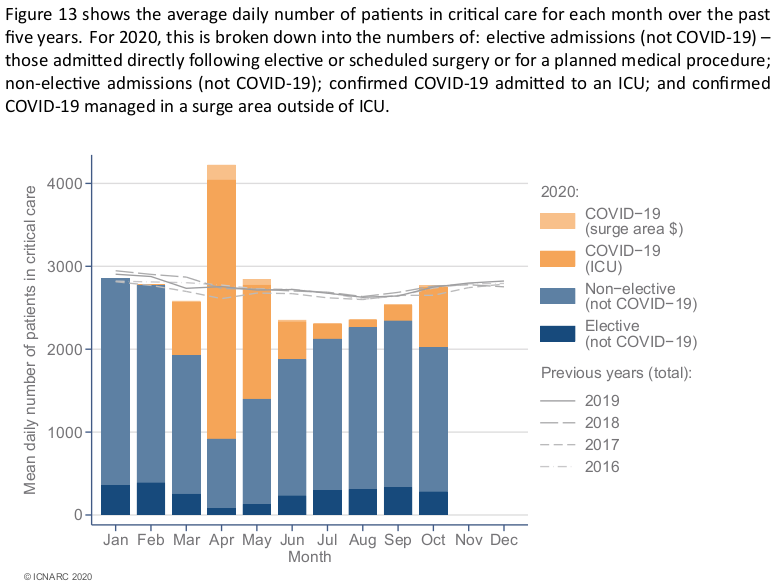by Neville Hodgkinson
Charts and graphs can sometimes convey more of what is going on than millions of words. Here is one such, from the latest report by the Intensive Care National Audit and Research Centre. It shows how many patients, as a daily average, were in critical care for each month over the past five years. The figures cover England, Wales and Northern Ireland.
The vertical columns show the monthly totals for 2020, and the four horizontal lines show the totals for the previous four years.

We can see clearly that after the huge spike that occurred in April, caused by COVID-19’s arrival, the monthly totals are either about the same, or less, than in all the previous years.
That includes October, when the UK was already being told we were in a second wave of the epidemic and must face drastic new restrictions in our lives to save the NHS from being overrun.
The October figure shows an increase in patients in critical care whose illness was attributed to Covid, but nowhere near that of the April peak. And it hasn’t continued to rise: latest figures show a decline in both admissions and deaths where Covid was involved.
Total deaths are running at about a fifth higher than the five-year average, though how much of that is attributable to the massive disruption of people’s lives caused by the lockdown, or to the virus, is questionable.
About 1,800 people die each day in England and Wales currently, and out of those about 430 are said to involve Covid. This is a far cry from the prediction of up to 4,000 deaths a day by this month, made in one of the slides shown by Chief Scientific Adviser Sir Patrick Vallance and Chief medical Officer Chris Whitty when they explained the necessity for a second national lockdown.
The figures have immense implications for Government policy. They call into question the value of the restrictions that are still in place, which are continuing to damage the wellbeing of millions.
They also provide powerful support for the case, now being pressed with an increasing sense of urgency by doctors and scientists in many parts of the world, that there is no justification for rushing out Covid vaccines, at enormous expense and all carrying some element of risk because of their experimental nature and the short-term testing involved.
These scientists say we are now in a “pseudo-epidemic”, caused by misinterpretation of results from widespread use of the PCR (polymerase chain reaction) genetic test for the virus.
One of the problems is that the test can identify genetic material from other coronaviruses. Since these also circulate more frequently in winter, they may account for some of the rise in positive COVID-19 test results. Yet the symptoms may be no worse than the common cold.
These pre-existing viruses may also be a contributory cause of death in some of the most vulnerable people, but since nobody was testing for them, their contribution previously went unnoticed.
What’s more, if the test is not handled properly – as has been shown to be the case with inexperienced staff in some hastily commissioned testing centres – it can throw up false-positive results for a variety of other reasons, including laboratory contamination, and detection of COVID-19 genetic sequences that are genuine, but which no longer signal active infection.
All this helps to explain why thousands of new ‘cases’ are being reported daily, while the numbers of critical care patients remain stable, and deaths show simple seasonal increases.
It is actually quite wrong to call them cases, as many of those being given this damaging label have no symptoms of illness, and may not represent a risk of infecting anyone else.
How has this sorry state of affairs come about?
I found it inexplicable for a while that governments globally, with very few exceptions, were following such similar, hugely damaging strategies in response to the arrival of the new virus. As far back as last March, world-class experts such as John Ioannidis, Professor of Medicine at Stanford University, were warning that “with lockdowns of months, if not years, life largely stops, short-term and long-term consequences are entirely unknown, and billions, not just millions, of lives may eventually be at stake.”
I suspect now that a key reason for the panic was high-level knowledge that the virus was a chimera – a product of so-called “gain-of-function” genetic engineering at China’s Wuhan Institute of Virology, part-financed by America’s National Institutes of Health, making it both more infectious and more damaging than existing coronaviruses. Despite very quick denials from the Chinese Government and others claiming a natural origin, considerable evidence points in this direction
Should that be the case, governments would regard it as against the public interest to be open about the fact, because of the panic that could cause. But could the panic have been any worse than what we have seen?
Now we know for sure that the virus, while capable of being deadly, is not the threat that might have been feared, an immediate review of the entire COVID-19 strategy is needed, with much greater openness about every aspect of this tragic episode.
Neville Hodgkinson is former medical and science correspondent of the Daily Mail and Sunday Times.













Donate
We depend on your donations to keep this site going. Please give what you can.
Donate TodayComment on this Article
You’ll need to set up an account to comment if you don’t already have one. We ask for a minimum donation of £5 if you'd like to make a comment or post in our Forums.
Sign UpLatest News
Next PostPostcard From the Maldives